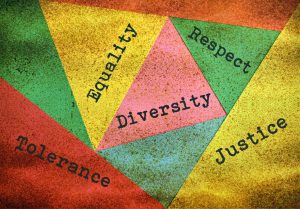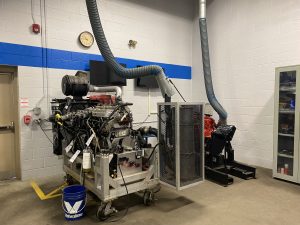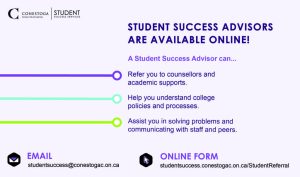3.2 Supporting Student Needs
Describe common student support needs
This section provides information on common student support needs and how faculty can be proactive in addressing them. It also provides information on how to respond to student needs that may arise, and where to access appropriate supports for students.
Supporting Student Needs Proactively
Faculty are the managers of the classrooms. Their responsibility is to create and maintain an environment that supports learning. See the sections below on ways that faculty can support students in their classes.
5-Minute Video Watch
View a short video overview about faculty’s role in being a proactive guide for supporting student needs with Ada Sharpe, Teaching and Learning Consultant.
Teaching and Learning. (2023). Being a proactive guide: How faculty can support student needs. [Online video]. Panopto.
Provide Inclusive Learning

Inclusion is providing equal access to opportunities and resources for people who might otherwise be excluded or marginalized, such as those who have physical or intellectual disabilities and members of other minority groups. Inclusion ensures that the learning experience in your classroom is accessible and challenging for all students. When learning environments are designed to reduce barriers, all learners can engage in learning.
Below are five examples of ways in which Conestoga has worked to provide a more inclusive learning environment for students. See Course Delivery Procedure.
- All materials used in a learning opportunity are posted in an electronic and accessible format on eConestoga before the class session.
- Faculty are asked to write on the board using a size of printing that is visual from all corners of the room and a marker colour with good contrast.
- All students are provided with an Instructional Plan prior to the start of the semester, enabling students to have a full course schedule for evaluation dates, key concepts, and resource use. Students can use this for planning study support, medical appointments, etc.
- No pop quizzes are permitted so that students have reduced anxiety and can make important appointments without fear of missing marks.
- Face forward when speaking so that students who need a clear vocal stream, a visual cue for lip reading or facial expression access have those elements.
Faculty should also encourage students with disabilities to contact Accessible Learning, a service that helps students obtain accommodations for any documented disabilities. Learn more about Accessibility at Conestoga.
Use Inclusive Language

Common phrases often go under the radar because people do not realize that the language can be derogatory and diminishing. Using a description of someone’s identity as a negative expression, such as “That’s so gay,” is insulting (and, in the case of the example, homophobic). Students have a right to freedom from harassment and discrimination of any kind, intentional or unintentional.
Inclusion is full participation and belonging for everyone. By using inclusive language, employees help to achieve the College’s mission: to serve its diverse community and inspire people toward their highest potential.
Conestoga’s Guidelines to Inclusive Language and other resources (Bouton, 2016; Nadal, 2014) describe simple ways to use inclusive language. For example,
- When speaking to a group, avoid expressions like “Ladies and Gentlemen” and “Hey guys.”
- Avoid euphemisms or language that can be demeaning to students. For example, do not refer to students with no hearing or hearing loss as “mute” or “hearing impaired.”
- Use students’ pronouns and respect their choice of self-naming.
- Listen to what students say, follow their suggestions, and check in.
- Intercede on comments or discussion that uses exclusive or discriminatory language.
Acknowledge Acculturative Stress

Moving to live in a new place, with a new culture and different types of classrooms, can be stressful. The reality for many of Conestoga’s international and Indigenous students is that they often face added economic, social, cultural, and linguistic pressures during their studies. These can include
- New cultural rules that are not easily recognizable
- Lack of money
- Thinking about long-term goals
- Language barriers
- New classroom expectations
- Isolation
- Distrust of an education system that has been part of a destructive colonialist history for Indigenous peoples and other former British colonies, such as Nigeria and India
Acculturative stress is the psychological impact of adaptation to a new culture (Acosta, 1979; Smart & Smart, 1995). Acculturative stress is a common experience for anyone who lives, works, and studies in a new language and/or culture. Stress inhibits learning. Zhang and Jung (2017) have identified five distinct but related dimensions of acculturative stress among Chinese international students, which may also apply to other students. These dimensions included:
- perceived discrimination
- fearfulness
- homesickness
- stress due to change
- guilt
Here are some simple ideas for helping students manage and reduce their acculturative stress in your classroom.
- Be welcoming and approachable
- Take an interest in your students
- Many faculty think some bi-lingual or multi-lingual students don’t respond because their English is weak. Do not make the assumption that they don’t know English if they don’t seem to be following you. Try pausing and rephrasing. They may just be unfamiliar with your way of speaking.
- Try clear, non-threatening instructions for classroom tasks and circulate them to help students ensure they are on the right track.
- Step up as a trusted leader – empower students but also advocate for them
- Give students opportunities to share about their culture and home
- Refer students to resources available to them
Embrace Classroom Diversity

International, newcomer, and Indigenous (including First Nations [status and non-status], Métis and Inuit) students bring many positive aspects to the Canadian classroom. They have different perspectives, abilities, and interests that can enrich understanding and learning for everyone.
Conestoga’s classrooms are rich in cultural diversity. The faculty member’s role is to support international and domestic students in integrating and learning together in the classroom. A diverse student group brings benefits and challenges to the classroom.
Faculty should take deliberate steps to embrace cultural, linguistic, and educational diversity as an opportunity for enrichment in the classroom. Educators can embrace transparency in the classroom with respect to fostering an appreciation for cultural diversity.
- Acknowledge the potential for students to have anxieties about multicultural collaborative work.
- Ease these anxieties by meeting students where they are.
- Share that while students often fear that multicultural collaborative work will lead to lower grades, research has found that this type of work results in higher grades for all parties when teachers support this process (Elliot & Reynolds, 2014).
- Encourage and provide opportunities for students to talk about, explore, and examine culture, identity, and race in relation to the course content. Ensure that the examples and content used in your teaching are diverse and representative.
- Do not make assumptions about students’ identities. For example, not all Indigenous people are visibly racialized, but this does not make their identity any less valid.
- Confront racism when you see it in the classroom. Stop the situation immediately and inform students it is not tolerated in class.
- Model respectful dialogue and assist students with how they can resolve differences and manage disputes informally with dialogue and guidance from you.
Encourage Effective Habits for Learning

In your course, students are not just learning the course content; they are also learning how to learn. As such, they may benefit from tips, suggestions, and supports for improving their learning and study skills in the classroom, lab, and shop spaces. Positive habits that you can reinforce include the following:
- Keeping a schedule and blocking time for work
- Referring to the Instructional Plan
- Taking responsibility for paying attention and minimizing distractions
- Taking notes during lessons and while reading
- Proofreading work carefully
- Using “spaced study” habits
- Using appropriate tools and technology to assist learning
- Seeking assistance to address needs and barriers to learning
Support Collaborative Group Work

Faculty are expected to prepare and support students to work together collaboratively in a classroom and in group work, where applicable. Collaborative work is team-based work that draws on the strengths and builds the skills of each member as the team works towards a set goal. Unlike much traditional group work, every effort is made to ensure the team functions well and collaborates. Take deliberate steps to embrace cultural, linguistic, and educational diversity as an opportunity for enrichment, specifically when it relates to collaborative work in the classroom.
- Encourage a strengths-based approach, where students identify and offer their specialized skills from the start.
- Do not let students divide the work into sections. Explain that each team member must work through, be knowledgeable about, and sign off on each section of the project.
- Explain that each student must individually show evidence of meeting the course outcomes associated with the project.
- Provide in-class time for students to organize, get started, and confirm progress on group projects.
- Meet with each group. Coach them. Check that all members are well-briefed on the project. Record what progress they have made.
- Insist that all communication and document exchange be carried out on eConestoga so no side deals that might exclude input from international students can occur.
- Tell the groups you may spot-check their eConestoga group discussions but mostly want them to be accountable and to approach you if there are challenges.
- Do not expect students to work off campus together – encourage safe meetings at the Library or with the use of technology.
Uphold Academic Integrity

Academic integrity is about honesty, fairness, and respecting others while pursuing academic excellence. Academic integrity occurs when learners do their own work and provide proper credit when using other people’s ideas. Upholding academic integrity is everyone’s responsibility and ensures that the credentials earned while attending Conestoga are valued and respected.
Some students may be less familiar or practiced with academic integrity, or do not clearly understand what constitutes academic misconduct.
Simple ways to create a culture of academic integrity in your classroom can include:
- Introducing the idea of academic integrity and its benefits for learning
- Describing the importance of integrity and credibility in your industry or field
- Clarifying the idea of intellectual property and the importance of attributions to acknowledge the words and ideas of others
- Showing students College-licensed tools to assist them, such as Turnitin and Grammarly
- Encouraging students to keep track of drafts and changes to their work
- Explaining the consequences of academic misconduct
- Inviting students to access Library holdings, APA resources, the Academic Integrity website, and other writing supports
- Giving students ideas for planning their schedules, including providing time for in-class work, so that students complete assignments by the due date
See the Academic Integrity website and Academic Integrity Officer about various academic incidents, ways to respond to alleged academic integrity cases, and how to report incidents of academic misconduct.
Support Mental Health and Wellness

Mental health is essential to students’ academic success as well as their ability to participate fully and meaningfully throughout all aspects of their lives and throughout their lifespan. As faculty, you play a pivotal role by understanding mental health in the context of wellness. Here are some ideas for decreasing stress and anxiety and supporting mental wellness for students.
- Post or share the agenda and plan for each class. Some students may need to leave class as a self-management strategy so they can recharge, take medication, or regain control.
- Set an example of how not to stigmatize languishing or struggling students. This may mean correcting students who might want to “label” classmates.
- Ask students for their names and pronouns on the first day of class. If you use nametags in your class, ask students to list their name and pronouns, if they feel comfortable, on their name tags (explain to students what pronouns are, as some students might be new to these ideas).
- Talk about health and health promotion with your students, and encourage extra-curricular involvement and social activity.
- Validate your students’ efforts if they are behind and struggling. Positive statements about their performance make them more likely to feel reassured and participate actively in realistic goal setting.
- Encourage students to access the physical and mental health and wellness supports available at the College.
Empowering students to participate actively in maintaining their well-being as well as addressing mental health issues sets the foundation for increased ability to sustain well-being throughout their lives.
5-Minute Web Search
Choose a topic of interest from the sections above, and search for that term in Conestoga’s Faculty Learning Hub. What do you find?
- Inclusion
- International / Indigenous Students
- Groups
- Academic integrity
- Mental health
Responding to Student Concerns and Needs
Faculty can support their students in their learning journeys by addressing their concerns as well as providing information to help students connect with the right support for their needs.
Address Concerns about Grades
Students may have questions or concerns about their exam or assignment grades, answers on assignments or tests, or feedback you have provided on their assignments.
As per the Evaluation of Student Learning Policy, students have the right to:
- Ask questions about their grades
- Be graded fairly and consistently using valid and reliable measures
- Be given constructive feedback on their grades
- Have access to their marked evaluations upon request
- Have an explanation of their grades upon request
A promptly scheduled face-to-face or synchronous online meeting is recommended to address student concerns in a kind and supportive way.
Supplementals
A Supplemental Evaluation is an evaluation provided to a student who meets the supplemental eligibility criteria to clear an academic deficiency.
If a student is just under a passing grade at the end of a course, that student may have the right to complete a supplemental assignment or exam.
According to the Evaluation of Student Learning Procedure,
“Faculty will advise students as to the Supplemental criteria.
a. Faculty will inform them that the Supplemental opportunity occurs after the final mark is posted, is time-sensitive, and may not be available for all courses” (p.2).
Read the Academic Handbook for the course(s) you teach about the specific rules for supplementals in your program. Contact your Program Coordinator or Chair/Chair Designate with further questions.
If a student passes the supplemental and the course, faculty then update the student’s grade in the Conestoga Laserfiche system.
Course Fail
In cases where a student has failed a course, the student may need to retake the course. Refer your student to the Academic Handbook and to a Student Success Advisor for next steps.
Grade Appeals
Support Referrals
Students may benefit from academic support to be successful in your course, but they may not seek out academic support on their own.
Writing and Citing Support Needs
The Library Writing and Citing website provides anytime resources as well as real-time consults for the following common writing and citing challenges:
- Understanding citation styles, such as APA
- Incorrect citation format and citation omissions to avoid plagiarism
- Effective use of sources to support arguments
- Writing in an academic tone and avoiding informal language
- Understanding assignment guidelines and meeting expectations
- Finding appropriate and quality research and resources
- Integrating quotes and paraphrased information into their own writing
- Time management and meeting deadlines for writing assignments
- Writing for the industry, field, or discipline
- Revising and editing written work to improve clarity and coherence
- Using technology tools to support writing
eText Support Needs
Faculty should encourage students to visit the Bookstore’s eText help page for assistance with accessing, using, and opting out of their course eText. Students should contact the Bookstore for questions about their eTexts and digital access codes.
FAQs, videos, and drop-ins are available to support students.
Technology Training
Faculty should encourage students to use the Library’s Teach Me Tech website to build their computer and laptop skill use and receive real-time tech help with frequently needed technology training and support:
- Using Zoom or MS Teams for synchronous online classes
- Using any required BYOD technology
- Using Microsoft software and other software as a student
- Using eConestoga
- Obtaining assistive technology and alternate formats
IT Support Needs for Students

For general questions about technical support, such as for help with Conestoga ID email or password, students may also email the IT Help Desk or through the IT home page’s 24/7 chat tool.
Student Learning and Records of Learning
The Co-Curricular Record (CCR) is an official document that recognizes the learning a student has achieved through approved co-curricular experiences at Conestoga College. Students can participate in activities that are recorded on their co-curricular record transcript. Experiences include workshops, clubs, committees, volunteer roles, and recreational opportunities. See the Co-Curricular Record website and FAQ.
Students have various backgrounds and prior educational experiences. Some may have previous learning experiences from other programs or courses at other institutions. Students may qualify for PLAR, or Prior Learning Assessment and Recognition. Students must pay a fee for a PLAR process. See the Credit Transfer and PLAR website for more information.
Work-integrated learning (WIL) integrates a student’s academic studies with learning in a workplace or practice setting. Examples include co-ops, field placements, and practicum placements. WIL can occur at the course or program level and includes the development of learning outcomes related to knowledge, skills, employability, and life-long learning. Hands-on learning opportunities are embedded into many programs at Conestoga. Students may need assistance with WIL processes; see the Pre-Workplace WIL FAQ.
Help Students to Navigate the System
Student Success Advisors

Student Success Advisors are the primary support for students facing academic challenges. As a supportive first point of contact, Student Success Advisors are a “first stop” for student support, as they will refer students to the College unit that best meets their needs.
Student Success Advisors can also help students book appointments with wellness and learning services and can assist students in working through college processes or problems.
Referral Forms
Asking for support is easy – students can use the online self-referral form, and a Student Success Advisor will reach out to set up a time to talk.
Alternatively, faculty submit a request for a Student Success Advisor to reach out on a student’s behalf through the Faculty Student Referral Form.
5-Minute Reflection
After reviewing the student support services on this page, consider the following reflection questions:
- Which issues are likely to arise in my classroom?
- Which support services can I recommend to students at the start at the beginning, middle, and end of the semester?
- When is it appropriate to refer a student to a Student Success Advisor?
References
Acosta, F. X. (1979). Barriers between mental health services and Mexican Americans: An examination of a paradox. American Journal of Community Psychology, 7, 503-520.
Bouton, K. (2016). Deaf? Hard of Hearing? Hearing Impaired? Be Careful What You Call Us. AARP.
Canadian Association of the Deaf (n.d.). Terminology. http://cad.ca/issues-positions/terminology/
Nadal, K. (2014). A guide to responding to microaggressions. Advancing Justice.
Smart, J. F., & Smart, D. W. (1995). Acculturative Stress: The Experience of the Hispanic Immigrant. The Counseling Psychologist, 23(1), 25–42. https://doi.org/10.1177/0011000095231003
Truth and Reconciliation Commission of Canada (2015). Honouring the Truth, Reconciling for the Future Summary of the Final Report of the Truth and Reconciliation Commission of Canada.
Zhang, Y., & Jung, E. (2017). Multi-Dimensionality of Acculturative Stress among Chinese International Students: What Lies behind Their Struggles? International Research and Review, 7(1), 23–43.
 Section 3.2 Review
Section 3.2 Review
Please pause and answer these nine practice questions to review and check your learning.
